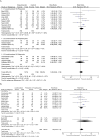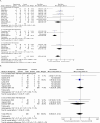Efficacy and safety of levetiracetam for pediatric convulsive status epilepticus in emergency settings: a systematic review and meta-analysis
- PMID: 40739189
- PMCID: PMC12308964
- DOI: 10.1186/s12883-025-04323-0
Efficacy and safety of levetiracetam for pediatric convulsive status epilepticus in emergency settings: a systematic review and meta-analysis
Abstract
Background: Status epilepticus is one of the most commonly occuring emergencies among children across the world. Time is crucial in the treatment of SE, with increasing risk of long term adverse events and sequelae with delay in treatment or action of drugs. This systematic review and meta-analysis aims to compare levetiracetam, a drug known for its comparatively safer profile, with other routinely used drugs in pediatric SE like phenytoin, fosphenytoin and valproate.
Methods: A comprehensive literature search was conducted across four databases from 1996 till November 2024. All original studies evaluating the efficacy of levetiracetam vis-a-vis other anti-seizure medications in pediatric children in an emergency setting were included in the study. Data analysis was conducted using RevMan software, using a random-effects model.
Results: A total of fourteen studies, comprising a patient population of 2,473, were included for further quantitative analysis. No differences were noted between the drugs when comparing seizure termination and recurrence at 24 h. Levetiracetam notably reduced the time to cessation of seizures when compared to phenytoin or fosphenytoin (MD=-3.97, 5% CI [-6.18, -1.76], p = 0.0004) and length of ICU stay over phenytoin (MD = 0.77, 95% CI [0.54, 1.00], p < 0.00001). A lower risk of adverse events was noted on use of levetiracetam over fosphenytoin (RR = 0.62, 95% CI [0.40, 0.96], p = 0.03); however risk of agitation was the least on use of phenytoin (RR = 3.90, 95% CI [1.42, 10.73], p = 0.008). Non significant differences in mortality rates were observed.
Conclusion: The study concludes better immediate effects of levetiracetam such as faster cessation of seizures. Levetiracetam was also suggested to stabilize patients faster, as implied by the lesser ICU stay and lower risk of adverse events. Further studies are needed to evaluate the efficacy of levetiracetam over other anti-seizure medications.
Keywords: Emergency department; Epilepsy; Levetiracetam; Pediatric; Phenytoin; Valproate.
© 2025. The Author(s).
Conflict of interest statement
Declarations. Ethics approval and consent to participate: Not applicable. Consent for publication: Not applicable. Competing interests: The authors declare no competing interests.
Figures





Similar articles
-
Antiepileptic drug monotherapy for epilepsy: a network meta-analysis of individual participant data.Cochrane Database Syst Rev. 2022 Apr 1;4(4):CD011412. doi: 10.1002/14651858.CD011412.pub4. Cochrane Database Syst Rev. 2022. PMID: 35363878 Free PMC article.
-
Drug management for acute tonic-clonic convulsions including convulsive status epilepticus in children.Cochrane Database Syst Rev. 2018 Jan 10;1(1):CD001905. doi: 10.1002/14651858.CD001905.pub3. Cochrane Database Syst Rev. 2018. PMID: 29320603 Free PMC article.
-
Antiepileptic drug monotherapy for epilepsy: a network meta-analysis of individual participant data.Cochrane Database Syst Rev. 2017 Dec 15;12(12):CD011412. doi: 10.1002/14651858.CD011412.pub3. Cochrane Database Syst Rev. 2017. Update in: Cochrane Database Syst Rev. 2022 Apr 1;4:CD011412. doi: 10.1002/14651858.CD011412.pub4. PMID: 29243813 Free PMC article. Updated.
-
Antiepileptic drug monotherapy for epilepsy: a network meta-analysis of individual participant data.Cochrane Database Syst Rev. 2017 Jun 29;6(6):CD011412. doi: 10.1002/14651858.CD011412.pub2. Cochrane Database Syst Rev. 2017. Update in: Cochrane Database Syst Rev. 2017 Dec 15;12:CD011412. doi: 10.1002/14651858.CD011412.pub3. PMID: 28661008 Free PMC article. Updated.
-
Anticonvulsant therapy for status epilepticus.Cochrane Database Syst Rev. 2014 Sep 10;2014(9):CD003723. doi: 10.1002/14651858.CD003723.pub3. Cochrane Database Syst Rev. 2014. PMID: 25207925 Free PMC article.
References
-
- Trinka E, Cock H, Hesdorffer D, Rossetti AO, Scheffer IE, Shinnar S, et al. A definition and classification of status epilepticus–Report of the ILAE task force on classification of status epilepticus. Epilepsia. 2015;56(10):1515–23. - PubMed
-
- Moshé SL, Perucca E, Ryvlin P, Tomson T. Epilepsy: new advances. Lancet. 2015;385(9971):884–98. - PubMed
-
- Smith PE. Management of established status epilepticus. N Engl J Med. 2019;381(22):2171–2. - PubMed
-
- Schubert-Bast S, Zöllner JP, Ansorge S, Hapfelmeier J, Bonthapally V, Eldar-Lissai A, Rosenow F, Strzelczyk A. Burden and epidemiology of status epilepticus in infants, children, and adolescents: A population-based study on German health insurance data. Epilepsia. 2019;60(5):911–20. 10.1111/epi.14729. Epub 2019 Apr 13. PMID: 30980677. - PubMed
Publication types
MeSH terms
Substances
LinkOut - more resources
Full Text Sources

